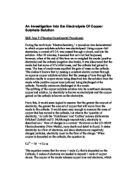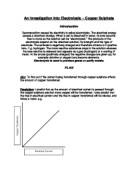An investigation into the factors which effect
The electrolysis of copper sulphate solution.
Task:
My task is to find out how we can increase the mass of the cathode, and how different methods affect it. We know that by passing an electric current through an aqueous copper sulphate solution, that ions passing through this solution will cause anions to be dissolved into the solution from the anode, and deposited on the cathode.
Diagram:
Equipment needed:
* 2 copper strips (anode and cathode)
* 50ml Copper sulphate solution (aq)
* 1 voltmeter
* 1 power supply
* 1 variable resistor
Method:
First, I shall weigh the anode and cathode, and label them. I shall then set up the experiment, as shown above, and set the current at 0.1 amps. I shall then leave it for 5 minutes for electrolysis to take place, before weighing the anode and cathode, and increasing the current to 0.2 amps, re-weighing the anode and cathode, then 0.3 amps and so on, up to 0.9 amps. I shall repeat this, but I do not feel that I shall have time to repeat it twice. To make sure that the amperage is set correctly as quickly as possible, I shall use the variable resistor. I shall watch the experiment continuously, to make sure that the anode and cathode do not touch, and in extreme circumstances, that the anode does not disintegrate due to electrolysis to the extent that it is no longer in the solution. To make it a fair test, I shall keep the amount of time the same for each, and try to set the amperage as quickly as possible. Also, before weighing the anode and cathode, I shall place them gently onto a paper towel, to remove some excess water, whilst being very careful not to remove any copper from the cathode. This should unfortunately be the most inaccurate part of the experiment. I shall obviously re-zero the scales before using each time to try and get as accurate results as possible. Possible variations are time, current, temperature of the solution, concentration of the solution, size of electrodes, distance between the electrodes and surface area of the electrodes. I have chosen current, as I think that it is more likely to produce results that could be useful in a conclusion. Also, I feel that it is an easy variable to measure and record, whilst at the same time maintaining the other variables at a constant level.
The electrolysis of copper sulphate solution.
Task:
My task is to find out how we can increase the mass of the cathode, and how different methods affect it. We know that by passing an electric current through an aqueous copper sulphate solution, that ions passing through this solution will cause anions to be dissolved into the solution from the anode, and deposited on the cathode.
Diagram:
Equipment needed:
* 2 copper strips (anode and cathode)
* 50ml Copper sulphate solution (aq)
* 1 voltmeter
* 1 power supply
* 1 variable resistor
Method:
First, I shall weigh the anode and cathode, and label them. I shall then set up the experiment, as shown above, and set the current at 0.1 amps. I shall then leave it for 5 minutes for electrolysis to take place, before weighing the anode and cathode, and increasing the current to 0.2 amps, re-weighing the anode and cathode, then 0.3 amps and so on, up to 0.9 amps. I shall repeat this, but I do not feel that I shall have time to repeat it twice. To make sure that the amperage is set correctly as quickly as possible, I shall use the variable resistor. I shall watch the experiment continuously, to make sure that the anode and cathode do not touch, and in extreme circumstances, that the anode does not disintegrate due to electrolysis to the extent that it is no longer in the solution. To make it a fair test, I shall keep the amount of time the same for each, and try to set the amperage as quickly as possible. Also, before weighing the anode and cathode, I shall place them gently onto a paper towel, to remove some excess water, whilst being very careful not to remove any copper from the cathode. This should unfortunately be the most inaccurate part of the experiment. I shall obviously re-zero the scales before using each time to try and get as accurate results as possible. Possible variations are time, current, temperature of the solution, concentration of the solution, size of electrodes, distance between the electrodes and surface area of the electrodes. I have chosen current, as I think that it is more likely to produce results that could be useful in a conclusion. Also, I feel that it is an easy variable to measure and record, whilst at the same time maintaining the other variables at a constant level.







